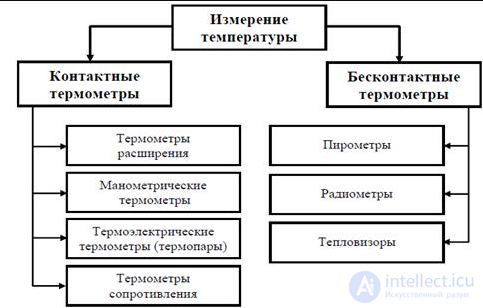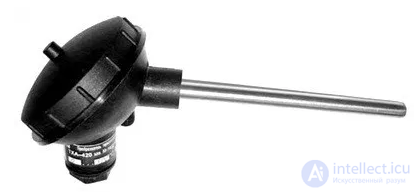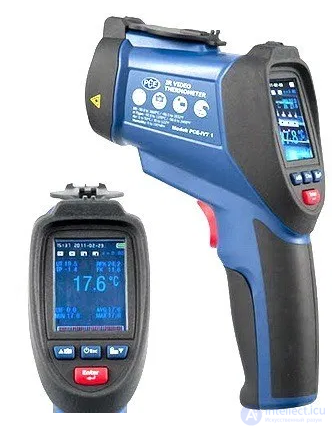Lecture
Temperature sensors are needed in order to monitor the temperature in a room, liquid, solid object or molten metal.
The basis of the action of temperature sensors in automated control is the change in temperature into an electrical signal. This leads to the advantages of electrical measurements: the results are easily transmitted over the network, the transmission speed can be quite high. Values can be converted to each other and vice versa. The digital code creates enhanced metering accuracy, speed and sensitivity.

Types and principle of action
Thermocouples
A thermocouple is two wires of different metals soldered together. With a temperature difference between the hot and cold ends, an electric current arises in the circuit. The magnitude of this electric current depends on the thermoelectric strength of the thermocouple, is from 40 to 60 μV, depending on the material of the thermocouple. The thermocouple material may be different. It can be nickel-chromium, chromium-aluminum, iron-nickel, iron-constantan, etc.

A thermocouple is a high-precision temperature sensor, but this accuracy is quite problematic to remove. A thermocouple is a relative temperature sensor, its voltage level is dependent on the temperature difference between the junctions. In this case, the cold junction is at room temperature or at some other.
Consider the operation of the thermocouple closer. There are two thermocouples and two hot and cold end temperatures. Accordingly, the EMF depends on the temperature difference. The temperature of the cold junction must be compensated. A hardware compensation method is the use of a second thermocouple, which is placed at a predetermined temperature.
A software compensation method is the use of another temperature sensor, this time an absolute one, which is placed in an isothermal chamber together with cold junctions and monitors their temperature with a given accuracy. There are difficulties reading data from the thermocouple.
Firstly , it is non-linear. GOST carefully introduced polynomial coefficients for converting EMF to temperature and vice versa. These polynomials are of a large order, but nothing prohibits them from being calmly counted by the controller.
Secondly , another problem is that the thermo-EMF of a thermocouple is measured in units and hundreds of microvolts. Accordingly, the use of widely available analog-to-digital converters will lead to complete failure. We need precision multi-bit low-noise analog-to-digital converters in order to use a thermocouple in their designs.
Thermistors
A much simpler way of measuring was the use of thermistors. They work on the dependence of the resistance of materials on external temperature. Metal resistance thermometers, in particular platinum, have very high accuracy and linearity. Resistance thermometers are determined by two main characteristics.

This is the basic resistance of the thermometer at a certain temperature. In GOST, the basic resistance is considered resistance at 0 degrees Celsius. GOST recommends the use of several resistance values in Ohms and a temperature coefficient, which is defined as the difference in the resistances of our temperature at 0 degrees divided by our temperature and t zero degrees multiplied by unity divided by the base resistance.
T cc = (R e - R 0c ) / (T e - T 0c ) * 1 / R 0c
In GOST on thermistors you will find the temperature coefficient for various thermometers made of platinum, copper and nickel. In addition, there are polynomial coefficients for calculating the temperature from the current resistance of the resistor. One of the problems with resistance thermometers is the very low temperature coefficient of resistance. However, measuring resistance with high accuracy is much simpler than very low voltage values, unlike thermocouples.
One way to measure the resistance is to include our thermal resistance in the circuit of the current source and measure the differential voltage. The use of semiconductors will give us a temperature coefficient of a fraction of a percent, they are much easier to measure using analog-to-digital converters. There are integrated circuits for temperature sensors, the analog output of which already corresponds to the supplied voltage. Such temperature sensors can be directly connected to an analog-to-digital converter and can be easily digitized using an eight- or ten-bit ADC.
Combined sensor
In addition to integrated circuits with an output, there are sensors with a digital interface. One of the popular sensors is the SHT1 Series Temperature and Humidity Sensor. This sensor allows you to measure temperature with an accuracy of + 2 degrees and humidity with an accuracy of + 5 degrees. The main problem of this temperature sensor is that they decided to optimize the interface. It allows you to connect parallel devices.
Digital sensor
The DS18B20 digital temperature sensor, which is a three-pin microcircuit, allows with high accuracy up to 0.5 degrees to obtain temperature with many sensors in parallel. This sensor has a wide temperature range from -55 to +125 degrees. Its main drawback is slowness. He does the calculations with maximum accuracy in 750 ms. Due to the inertia of the temperature sensor housing, it makes no sense to interrogate him.
Contactless sensors (pyrometers)

This sensor has a special thin film that absorbs infrared radiation, thereby heating up. Such non-contact thermal sensors are used in thermal imagers. There is not one thermal sensor, but a matrix. They allow detecting a thermal object at a distance of up to 3 meters.
Quartz Temperature Transmitters
In order to measure the temperature in the range of -80 +250 degrees, quartz transducers are used. They operate on the frequency dependence of quartz on temperature. The action of the sensors occurs on the frequency dependence. The function of the converter varies from the location of the slice along the axes of the crystal.
Quartz sensors work with high sensitivity, resolution, stability. These properties make them promising to use. They are widely used in digital thermometers.
Noise temperature sensors
The operation of noise sensors consists in the dependence of the noise potential difference on the resistor on temperature. In practice, it is possible to implement a method of measuring temperature by noise sensors by comparing the noise of 2 identical resistors, one is at a certain temperature, and the second is at a measured temperature. Noise temperature sensors are used for the temperature range of -270 -1100 degrees.
The advantage of noise sensors was the ability to measure temperature in thermodynamics on the above patterns. But this is complicated by the difficult measurement of noise voltage, since it is small and comparable to the noise of an amplifier.
NQR (nuclear quadrupole resonance) temperature sensors
NQR thermometers operate due to the action of the gradient of the current field of the crystal lattice and the moment of the nucleus, which is caused by the deviation of the charge from the symmetry of the sphere. This creates a procession of nuclei. The frequency depends on the gradient of the lattice field. For different substances, it has a value of up to thousands of MHz. The gradient depends on temperature, with its increase the frequency of NQR decreases.
NQR temperature sensors form an ampoule with a substance placed in an inductance winding, which is connected to the generator circuit. When the generator frequency coincides with the NQR frequency, the generator energy is absorbed. The temperature tolerance of -263 degrees is + 0.02 degrees, and the temperature is 27 degrees + 0.002 degrees. The advantage of NQR thermometers is stability, unlimited in time, the disadvantage is the significant non-linearity of the converting function.
Volumetric Converters
Volumetric sensors act on the expansion and contraction of substances with a change in temperature. The range of action of the converters is determined by how stable the properties of the materials. Sensors make temperature measurements in the range of -60 -400 degrees. Measurement tolerance is from 1 to 5%. The interval of operation of the sensor with the liquid may depend on the boiling and freezing temperatures. The measurement errors of sensors on liquids from 1 to 3% are determined by the temperature of the medium.
The lower boundary of the measurement of gas converters is determined by the temperature of the transition of the gas into a liquid state, the upper boundary is the resistance of the cylinder to temperature.
Temperature Sensor Selection Parameters
Comments
To leave a comment
Sensors
Terms: Sensors